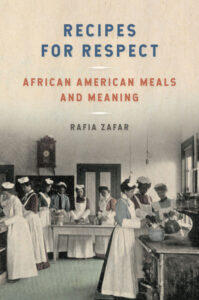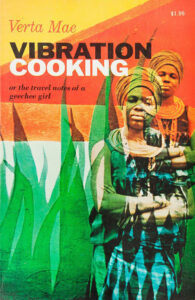Rafia Zafa, author of the new book “Recipes for Respect: African American Meals and Meaning,” discusses her own culinary journey and the ways African-American authors — in cookbooks, novels, poems, memoirs and how-to guides — have quite literally written their way to freedom.

Few chefs of African descent work at the pinnacle of our national haute cuisine today, yet their contributions to American kitchens and dining rooms have been definitive.”
So argues Rafia Zafar, professor of English and of African-American studies, both in Arts & Sciences, at Washington University in St. Louis. In her new book, “Recipes for Respect: African American Meals and Meaning,” Zafar traces how black Americans, over the last 200 years, have profoundly shaped the nation’s gastronomical heritage — while routinely being stereotyped as illiterate kitchen geniuses.
In this Q&A, Zafar discusses her own culinary journey and the ways African-American authors — in cookbooks, novels, poems, memoirs and how-to guides — have quite literally written their way to freedom.
You’re a skilled amateur chef. Was your family serious about food?
No, we weren’t fancy cooks. My mother was a terrible cook, as a matter of fact. My sister and I like to say we learned to cook in self-defense.
But I grew up in New York, and as a teenager got a job at Dean & DeLuca. I think I was Giorgio DeLuca’s first employee, and one of my high school friends later became a prominent restaurateur. It got me very interested in food.
So what was considered “fine dining” back then?
It was always French. French was the cuisine. But when I went out to dinner, I didn’t have a lot of money, and I tended to patronize these fabulous little restaurants that served both Cuban food and Cantonese-style Chinese food. You could start with rice and beans, get some wonton soup, end with flan. It was great.
But it wasn’t quite what we think of as fusion. In the Batista and Castro eras, a lot of ethnic Chinese who lived in Cuba emigrated to New York, and brought their cuisines with them. It just happened naturally.
You begin “Recipes for Respect” with the story of Robert Roberts. Tell us about him.
Robert Roberts was born in the South, a free black man, and later became active in abolitionist circles in antebellum Boston. He was also butler to Christopher Gore, the former governor of Massachusetts. In 1827, Roberts published “The House Servant’s Directory: A Monitor for Private Families,” which was basically his guide to running an upper-class household.
Twenty years later, Tunis G. Campbell, who had been principal waiter at the Howard Hotel in New York, and later a Georgia state senator during Reconstruction, published a similar volume, “The Hotel Keepers, Head Waiters, and Housekeepers’ Guide.”
So there’s an interesting paradox. In both cases, you have black men writing hospitality books that taught white readers how to move up socially.
You also discuss figures like Rufus Estes, Malinda Russell and Abby Fisher, whose popular cookbooks, written in the decades after the Civil War, combined instruction with elements of the slave memoir.
These manuals inaugurated the canon of black-authored cookbooks and documented a nascent black middle class of hospitality entrepreneurs. They also heralded a new literary form: the life story with recipes.
Along with cooking and baking skills, Estes, Russell and Fisher connect the black American past to their own interests, experiences and hard-earned successes. Russell relates various incidents during her flight out of the South. Estes wanted to be known as an accomplished chef and a former slave. To be both underscored the professional heights to which he had climbed.
Fisher delineates her past more obliquely, but includes a list of well-off patrons who valued her culinary skills. She correctly saw her talents as bankable.
Some of these writers may have been born as slaves, but they died as chefs.
In 1970, Verta Mae Smart-Grosvenor published her influential “Vibration Cooking.” In 1978, Carole and Norma Jean Darden released their equally celebrated “Spoonbread and Strawberry Wine.” Both books include recipes for hoppin’ John. What can we learn from the ways those recipes are written?
 Hoppin’ John is a New Year’s dish, made with black-eyed peas and rice. And it’s a signifying dish. It’s one of those dishes that tells a story.
Hoppin’ John is a New Year’s dish, made with black-eyed peas and rice. And it’s a signifying dish. It’s one of those dishes that tells a story.
The Darden sisters were from New Jersey, their father was a dentist, they attended Sarah Lawrence. They were concerned about middle-class people losing their roots. Their recipes are very formal, very careful, filled with step-by-step instructions.
Verta Mae Smart-Grosvenor’s family was more recently from the South, with direct roots to South Carolina. Her tone is folksy, wise-cracking and idiosyncratic, and she doesn’t let strict adherence to tradition overrule the spirit of the occasion. How you cook things, how you season, that’s your business. Her recipe for hoppin’ John is four lines long:
Cook black-eyed peas.
When they are almost done add rice.
Mix rice and peas together.
Season and — voila!— you got it.
Eating cannot be separated from social identity or historical context. The Dardens wanted to show readers how to recreate a kind of gastronomical blackness; Smart-Grosvenor sees cooking as an agent of change. Together, these women demonstrated that there is neither a monolithic black culture nor a single African-American cuisine.
Zafar will read from “Recipes for Respect”at 7 p.m. Thursday, March 21, at Subterranean Books, 6275 Delmar. For more information, visit store.subbooks.com.
In addition, Washington University Libraries will host a book talk with Zafar at 4:30 p.m. Thursday, April 18. For more information, visit library.wustl.edu.
This article originally appeared in The Source.




